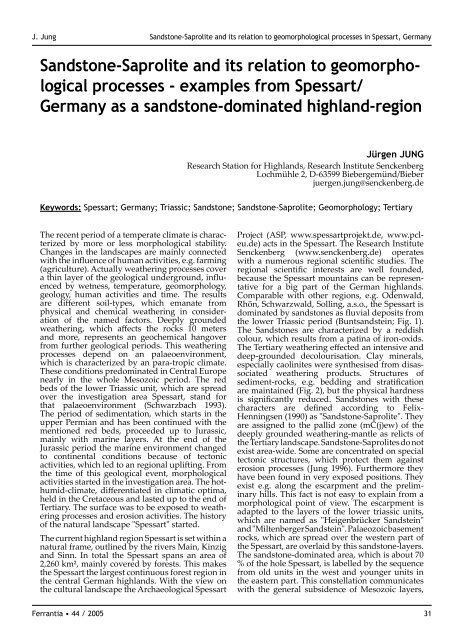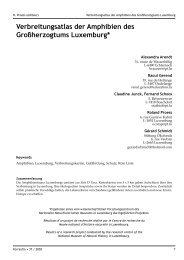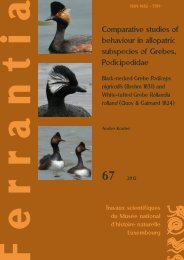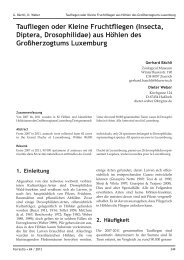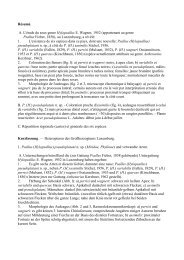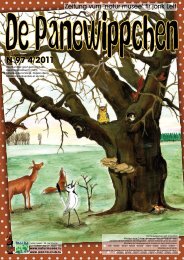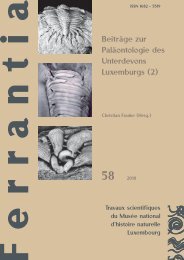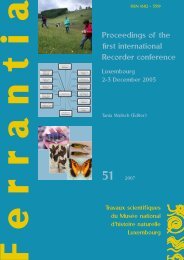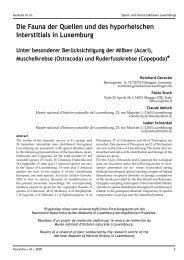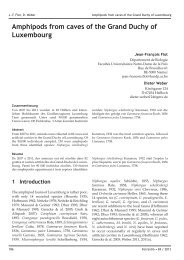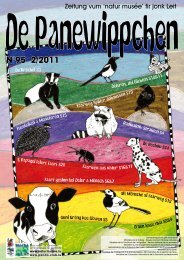Publi.complète - Musée national d'histoire naturelle
Publi.complète - Musée national d'histoire naturelle
Publi.complète - Musée national d'histoire naturelle
You also want an ePaper? Increase the reach of your titles
YUMPU automatically turns print PDFs into web optimized ePapers that Google loves.
J. Jung Sandstone-Saprolite and its relation to geomorphological processes in Spessart, Germany<br />
Sandstone-Saprolite and its relation to geomorphological<br />
processes - examples from Spessart/<br />
Germany as a sandstone-dominated highland-region<br />
Ferrantia • 44 / 2005<br />
Jürgen JUNG<br />
Research Station for Highlands, Research Institute Senckenberg<br />
Lochmühle 2, D-63599 Biebergemünd/Bieber<br />
juergen.jung@senckenberg.de<br />
Keywords: Spessart; Germany; Triassic; Sandstone; Sandstone-Saprolite; Geomorphology; Tertiary<br />
The recent period of a temperate climate is characterized<br />
by more or less morphological stability.<br />
Changes in the landscapes are mainly connected<br />
with the influence of human activities, e.g. farming<br />
(agriculture). Actually weathering processes cover<br />
a thin layer of the geological underground, influenced<br />
by wetness, temperature, geomorphology,<br />
geology, human activities and time. The results<br />
are different soil-types, which emanate from<br />
physical and chemical weathering in consideration<br />
of the named factors. Deeply grounded<br />
weathering, which affects the rocks 10 meters<br />
and more, represents an geochemical hangover<br />
from further geological periods. This weathering<br />
processes depend on an palaeoenvironment,<br />
which is characterized by an para-tropic climate.<br />
These conditions predominated in Central Europe<br />
nearly in the whole Mesozoic period. The red<br />
beds of the lower Triassic unit, which are spread<br />
over the investigation area Spessart, stand for<br />
that palaeoenvironment (Schwarzbach 1993).<br />
The period of sedimentation, which starts in the<br />
upper Permian and has been continued with the<br />
mentioned red beds, proceeded up to Jurassic,<br />
mainly with marine layers. At the end of the<br />
Jurassic period the marine environment changed<br />
to continental conditions because of tectonic<br />
activities, which led to an regional uplifting. From<br />
the time of this geological event, morphological<br />
activities started in the investigation area. The hothumid-climate,<br />
differentiated in climatic optima,<br />
held in the Cretaceous and lasted up to the end of<br />
Tertiary. The surface was to be exposed to weathering<br />
processes and erosion activities. The history<br />
of the natural landscape "Spessart" started.<br />
The current highland region Spessart is set within a<br />
natural frame, outlined by the rivers Main, Kinzig<br />
and Sinn. In total the Spessart spans an area of<br />
2,260 km², mainly covered by forests. This makes<br />
the Spessart the largest continuous forest region in<br />
the central German highlands. With the view on<br />
the cultural landscape the Archaeological Spessart<br />
Project (ASP, www.spessartprojekt.de, www.pcleu.de)<br />
acts in the Spessart. The Research Institute<br />
Senckenberg (www.senckenberg.de) operates<br />
with a numerous regional scientific studies. The<br />
regional scientific interests are well founded,<br />
because the Spessart mountains can be representative<br />
for a big part of the German highlands.<br />
Comparable with other regions, e.g. Odenwald,<br />
Rhön, Schwarzwald, Solling, a.s.o., the Spessart is<br />
dominated by sandstones as fluvial deposits from<br />
the lower Triassic period (Buntsandstein; Fig. 1).<br />
The Sandstones are characterized by a reddish<br />
colour, which results from a patina of iron-oxids.<br />
The Tertiary weathering effected an intensive and<br />
deep-grounded decolourisation. Clay minerals,<br />
especially caolinites were synthesised from disassociated<br />
weathering products. Structures of<br />
sediment-rocks, e.g. bedding and stratification<br />
are maintained (Fig. 2), but the physical hardness<br />
is significantly reduced. Sandstones with these<br />
characters are defined according to Felix-<br />
Henningsen (1990) as "Sandstone-Saprolite". They<br />
are assigned to the pallid zone (mC(j)ew) of the<br />
deeply grounded weathering-mantle as relicts of<br />
the Tertiary landscape. Sandstone-Saprolites do not<br />
exist area-wide. Some are concentrated on special<br />
tectonic structures, which protect them against<br />
erosion processes (Jung 1996). Furthermore they<br />
have been found in very exposed positions. They<br />
exist e.g. along the escarpment and the preliminary<br />
hills. This fact is not easy to explain from a<br />
morphological point of view. The escarpment is<br />
adapted to the layers of the lower triassic units,<br />
which are named as "Heigenbrücker Sandstein"<br />
and "Miltenberger Sandstein". Palaeozoic basement<br />
rocks, which are spread over the western part of<br />
the Spessart, are overlaid by this sandstone-layers.<br />
The sandstone-dominated area, which is about 70<br />
% of the hole Spessart, is labelled by the sequence<br />
from old units in the west and younger units in<br />
the eastern part. This constellation communicates<br />
with the general subsidence of Mesozoic layers,<br />
31


